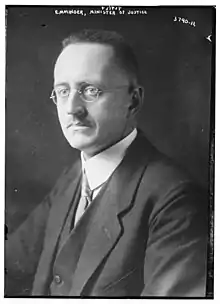Erich Emminger | |
|---|---|
 | |
| Minister of Justice | |
| In office 30 November 1923 – 15 April 1924 | |
| Chancellor | Wilhelm Marx |
| Preceded by | Gustav Radbruch |
| Succeeded by | Curt Joël (acting) |
| Personal details | |
| Born | 25 June 1880 Eichstätt, Germany |
| Died | 30 August 1951 (aged 71) Munich, Germany |
| Political party | Zentrum BVP |
| Alma mater | Münster University |
| Profession | Lawyer |
Erich Emminger (25 June 1880 – 30 August 1951) was a German lawyer and Catholic politician of the Center Party (Zentrum) and later of the Bavarian People's Party (BVP).
He served as Minister of Justice in the Weimar Republic from 30 November 1923 until 15 April 1924 under Chancellor Wilhelm Marx.[1]
Early life
Erich Emminger was born on 25 June 1880 in Eichstätt, Bavaria. His parents were Johann Adolf Erich Emminger (1856–1909), a Gymnasialprofessor, and his wife Marie Therese (1854–99), née Müller, daughter of an Augsburg notary. Emminger married Maria Schärft in 1906. Their children included Otmar Emminger, who became president of the Deutsche Bundesbank.[2]
Following his training as a lawyer at Münster, Emminger practiced law at Augsburg (1906–08) and Nuremberg (1908–09). In 1909 he became a civil servant (state prosecutor and district judge). He participated in World War I first as a voluntary soldier and later as a Kriegsgerichtsrat (judge-advocate).[2]
Political career
Emminger was a member of the Catholic Center Party (Zentrum) and, from 1913 to 1918 held a seat in the Imperial Reichstag for the constituency of Weilheim. In 1918, he joined the Bavarian People's Party (BVP) and represented it in the Weimar Reichstag 1920-33.[2]
Emminger was Minister of Justice in the first cabinet of Chancellor Wilhelm Marx, which took office on 30 November 1923. His tenure was defined by the passage of the three decrees of 22 December 1923, 4 January and 13 February 1924,[2] which were based on the Marx Enabling Act (Marxsches Ermächtigungsgesetz) of 8 December 1923.[3][4] These significantly changed civil and criminal law and the judiciary system with an eye towards speeding up proceedings. The reform of 4 January became known as the so-called Emminger Reform that among other things abolished the jury as trier of fact and replaced it with the mixed system of judges and lay judges in Germany's judiciary which still exists today.[5][6][7] Jury courts (Schwurgerichte), formerly based on jurors, kept their name but were in fact replaced by lay judges. Since the reforms were successful, they were kept in place by later legislation once the enabling act had lapsed.[2]
Late 1923 was among the most tumultuous times of the Weimar Republic, bringing the peak of hyperinflation[8] and the ongoing Occupation of the Ruhr.[3][9] One of Emminger's main goals as a politician and lawyer became a revaluation of the currency to partially offset the adverse social consequences of hyperinflation. As a minister he prevented the planned revaluation ban (Aufwertungsverbot) from becoming law and continued to fight for revaluation as a Reichstag delegate.[2]
Emminger left office on 15 April 1924 and his State Secretary, Curt Joël, took over as acting Minister of Justice. He remained a member of the judiciary committee (Rechtsausschuss) of the Reichstag and in 1927-31 served as chairman of the Central Board of the German-Austrian Working Group (Zentralvorstand der deutsch-österreichischen Arbeitsgemeinschaft), which worked towards a harmonisation of German and Austrian laws. He also contributed to a reform of the criminal law.[2]
Emminger was re-elected to the Reichstag in 1933 but the Nazi takeover ended his political activities. He worked as a judge at the State Supreme Court (Oberste Landesgericht) of Bavaria in 1931-35 and then at the Provincial High Court (Oberlandesgericht). From 1946 until his retirement in July 1949, he was Senatspräsident there.[2]
Emminger died in Munich on 30 August 1951.[2]
Publications
- Die Aufwertungsfrage im aufgelösten Reichstage (The Revaluation Question in the Dissolved Reichstag), 1924
References
- ↑ "Kabinette von 1919 bis 1933 (German)". Deutsches Historisches Museum. Archived from the original on March 5, 2012. Retrieved 12 July 2015.
- 1 2 3 4 5 6 7 8 9 "Biografie Erich Emminger (German)". Bayerische Nationalbibliothek. Retrieved 12 July 2015.
- 1 2 Mulligan 2005, p. 173.
- ↑ Casper & Zeisel 1972, p. 140.
- ↑ Vogler 2005, p. 244.
- ↑ Kahn-Freund 1974, footnote 73, p. 18.
- ↑ Casper & Zeisel 1972, p. 135.
- ↑ Fischer 2010, p. 64.
- ↑ Shirer 1990, p. 64.
- Mulligan, William (2005). The creation of the modern German Army: General Walther Reinhardt and the Weimar Republic, 1914-1930. Monographs in German History. Vol. 12. ISBN 978-1-57181-908-6.
- Shirer, William L. (1990). The Rise and Fall of the Third Reich: A History of Nazi Germany. Simon and Schuster. ISBN 978-0-671-72868-7.
- Fischer, Wolfgang Chr. (2010). German Hyperinflation 1922/23: A Law and Economics Approach. BoD – Books on Demand. ISBN 978-3-89936-931-1.
- Casper, Gerhard; Zeisel, Hans [in German] (January 1972). "Lay Judges in the German Criminal Courts". Journal of Legal Studies. 1 (1): 135–191. doi:10.1086/467481. JSTOR 724014. S2CID 144941508.
- Vogler, Richard (2005). A World View of Criminal Justice. International and Comparative Criminal Justice. ISBN 978-0-7546-2467-7.
- Kahn-Freund, Otto (January 1974). "On Uses and Misuses of Comparative Law". Modern Law Review. 37 (1): 1–27. doi:10.1111/j.1468-2230.1974.tb02366.x. JSTOR 1094713.
External links
 Media related to Erich Emminger at Wikimedia Commons
Media related to Erich Emminger at Wikimedia Commons- Erich Emmminger at the Akten der Reichskanzlei online version (German)
- Bio of Erich Emminger in a databank on (Imperial) Reichstag delegates (German)
- More biographical information on Erich Emminger, Datenbank der deutschen Parlamentsabgeordneten (German)
.svg.png.webp)